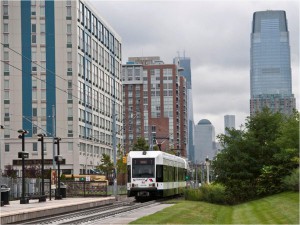OFF TRACK? An Assessment of Mixed-Income Housing around New Jersey’s Transit Stations
Can towns use housing development to improve or strengthen the areas around their train stations? The short answer is yes, but the type of housing will vary town by town, depending on the current mix of housing available.
New Jersey Future’s latest report, OFF TRACK? An Assessment of Mixed-Income Housing around New Jersey’s Transit Stations, assesses the degree to which the distribution of household income within each transit station’s immediate neighborhood matches up with, or departs from, the distribution of household income in the larger region in which the station is located. By understanding this divergence, towns will be better able to make decisions about the types of housing they should be zoning for and encouraging.
New Jersey’s extensive public transportation system is a valuable resource, allowing residents in many parts of the state to get from one place to another without having to drive on an increasingly congested highway network. Many of the neighborhoods surrounding the system’s 244 stations offer residents the opportunity to reduce their transportation expenses, sometimes enabling households to own fewer vehicles than they would otherwise need, or even no vehicles at all. And because many transit-hosting towns were originally built in a compact, walkable pattern to facilitate pedestrian access to the transit station, and often with a mixed-use downtown that treats the transit station as its focal point, residents of these places can accomplish many of their daily activities with much shorter travel distances than is the case in car-dependent suburbs.
But are the cost- and time-saving opportunities of transit-oriented development (TOD) accessible to everyone? Or are some transit-station neighborhoods effectively accessible only to upper-income households, due to a lack of diversity in housing options or to an insufficient supply of housing in general? Conversely, are some transit stations lying fallow in distressed neighborhoods, falling short of their potential to serve as hubs of activity and commerce for their communities? (In the latter case, the benefits for households with lower incomes of living near transit can be counteracted by the social ills that are associated with concentrations of poverty.) These are the questions the report set out to answer.
Analysis found that the state’s transit-station neighborhoods are definitely not all created equal, in terms of the degree to which they offer the benefits of living near transit to households of all income levels. On one hand, a surprisingly large number of transit stations –109 out of the 244 – have a higher percentage of single-family detached housing units in their surrounding neighborhoods than the statewide average. From a regional equity standpoint, a housing supply skewed toward single-family detached units, which are generally more expensive than other housing types like apartments or townhouses, can price out many households of more modest means, leaving the neighborhood and its mobility opportunities available only to wealthier residents. A prevalence of single-family detached housing near transit is also counterintuitive from a ridership standpoint, since the utility of public transportation rises in direct proportion to the number of people (and jobs) within easy walking distance of the station, and the best way to put more people within walking distance is by increasing the density of housing.
Other stations have the opposite problem. Not every place has been able to capitalize on the renewed demand for walkable, mixed-use, transit-accessible living that has resurfaced in the wake of the Great Recession; some station-area neighborhoods remain characterized by chronic disinvestment and concentrated poverty. In almost every case, a high concentration of households at the low end of the income spectrum is accompanied by a scarcity of households at the high end, illustrating the challenges involved in inducing middle- and upper-income households to locate into long-distressed areas. In fact, upper-income households are more uniformly rare in generally lower-income station areas than are lower-income households in more upper-income station areas.
While the report specifically looks at the income characteristics around New Jersey’s transit stations, the same analysis can be applied to towns without transit centers. Towns with compact, walkable downtowns can conduct this same assessment to see where they stand and where they should be heading, and New Jersey Future can help develop these assessments. Creating a healthy mix of housing types within a community will benefit the long-term economic health and viability of towns across the state, but it is important for towns to face these issues with information and an eye toward the future.












